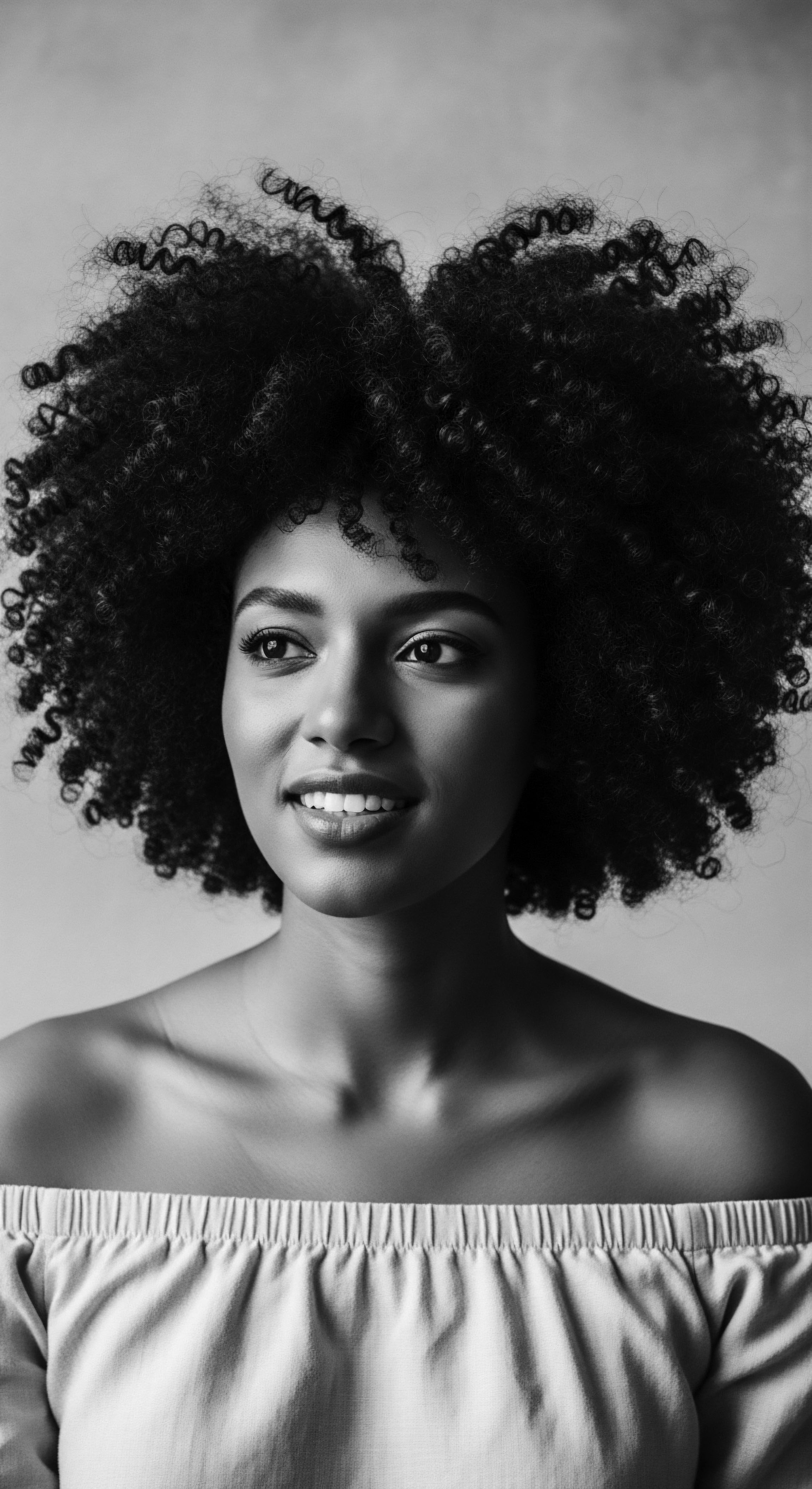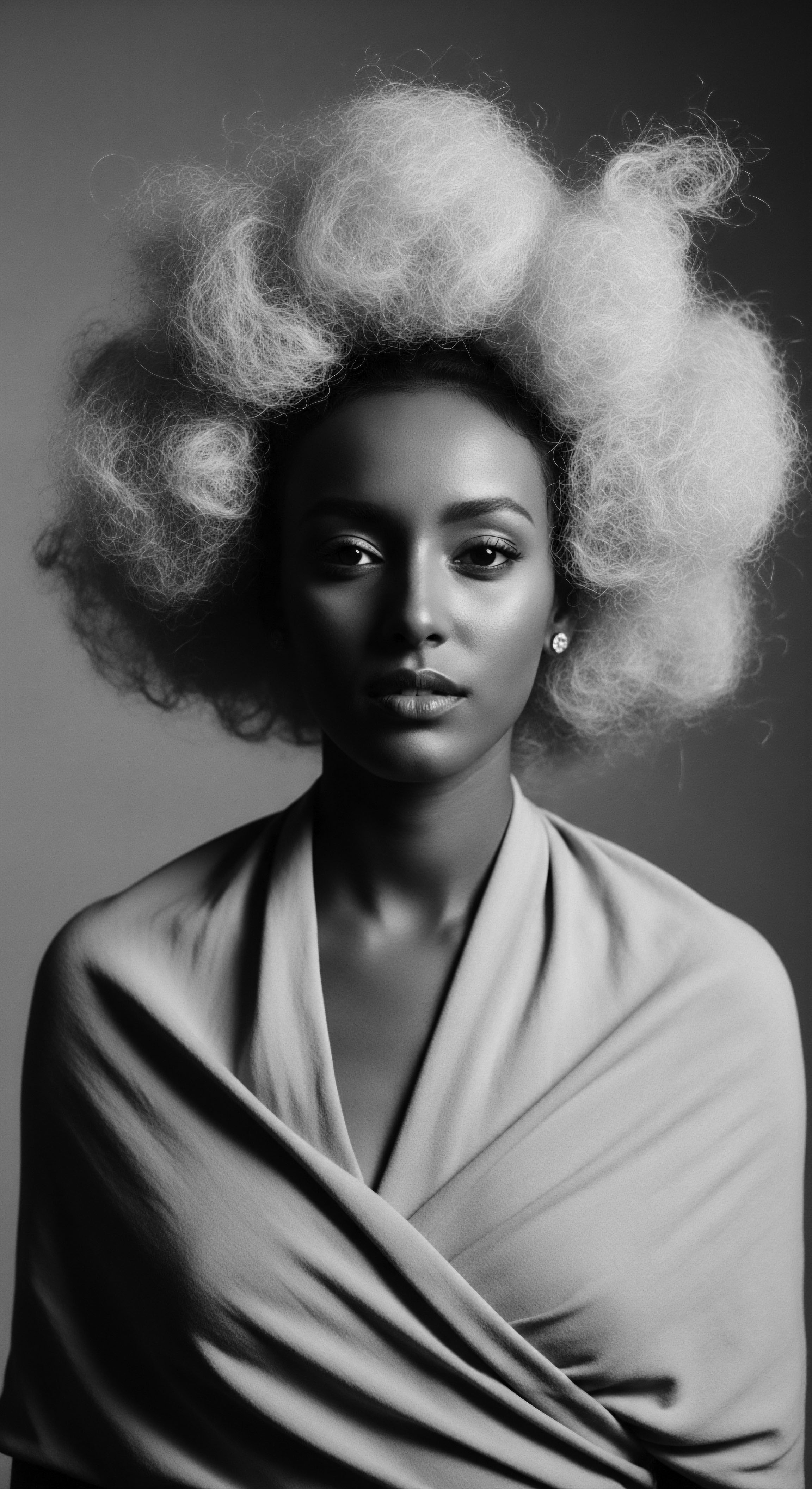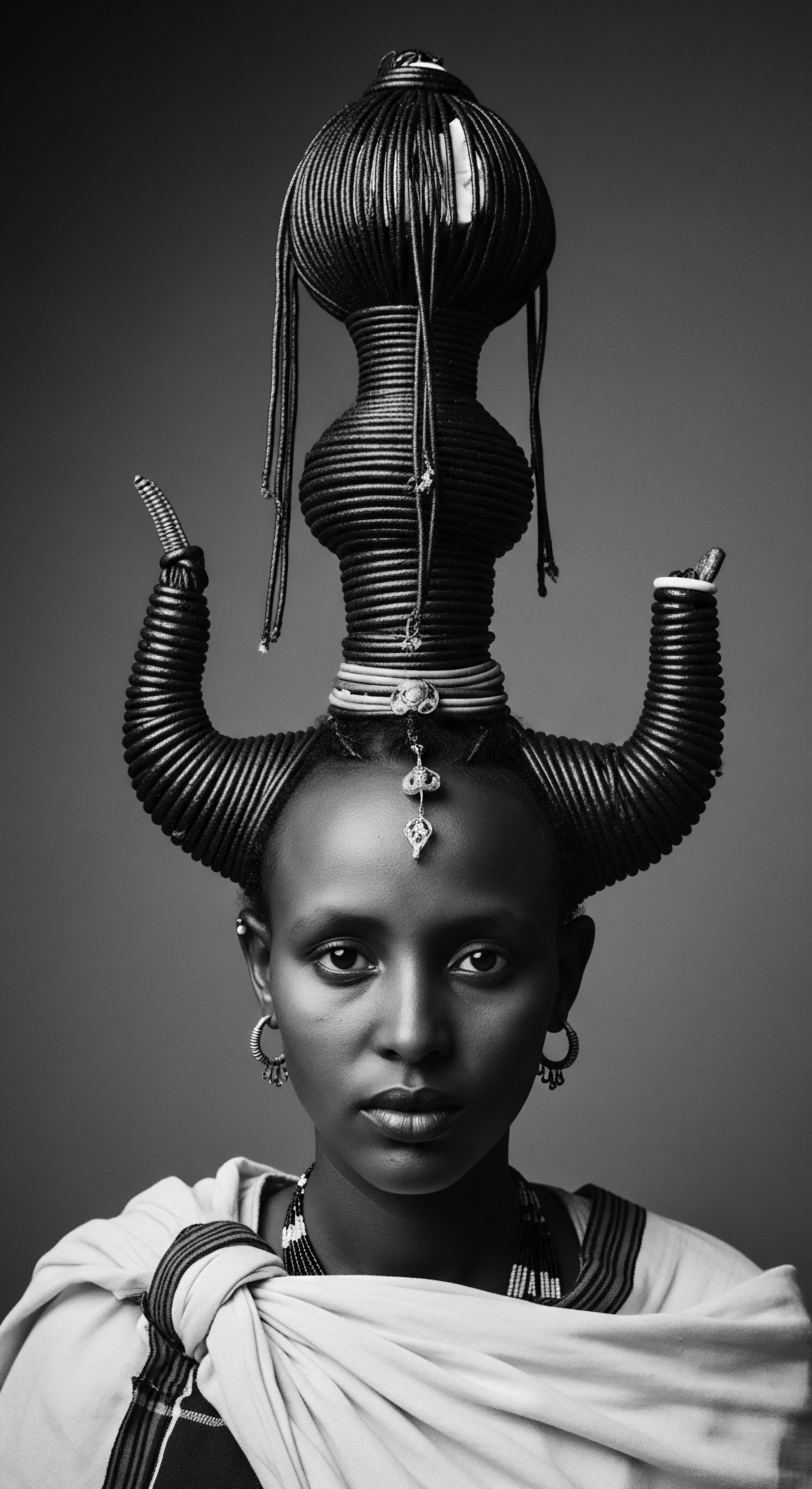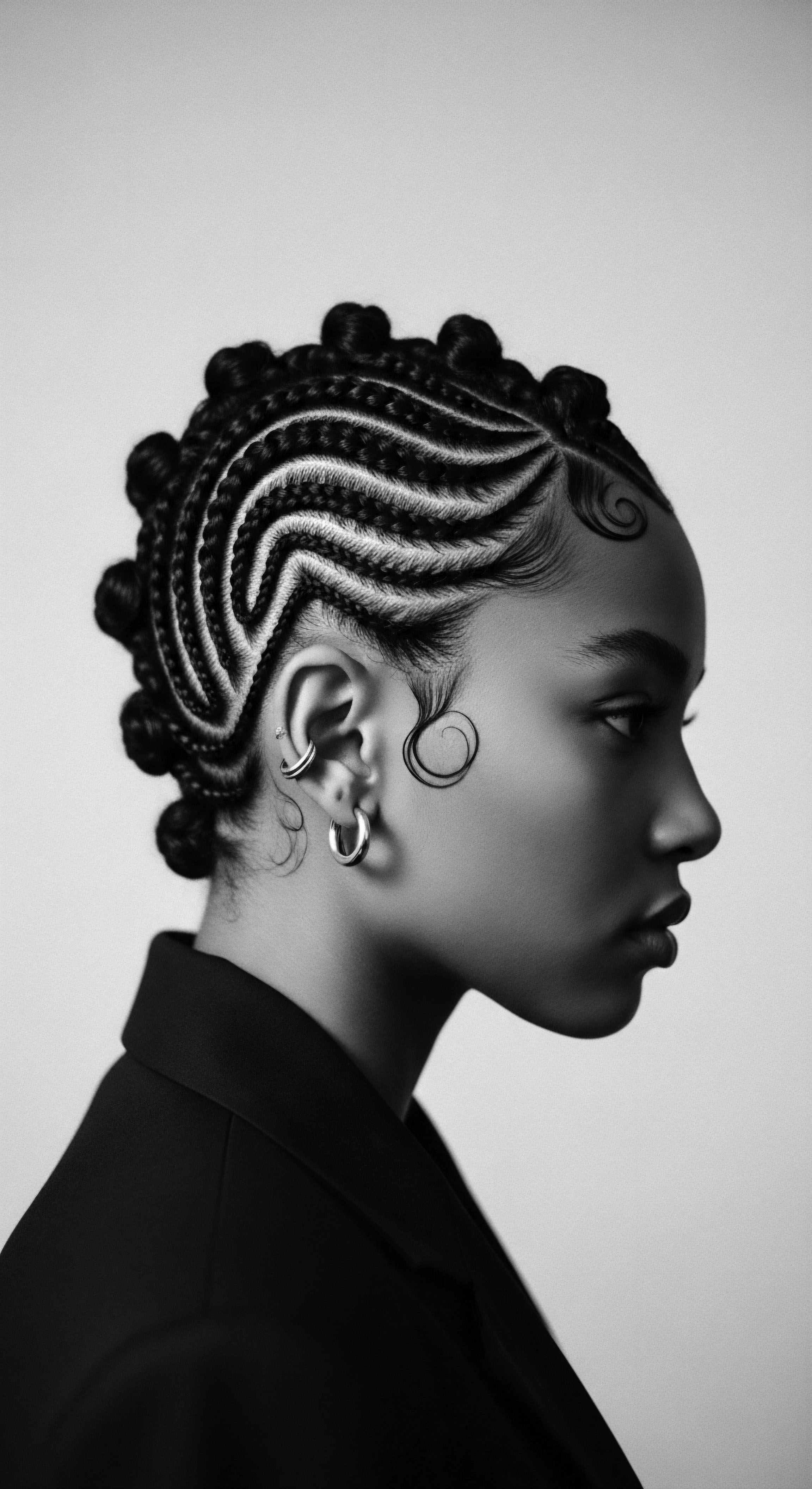
Roots
To truly comprehend what specific properties of castor oil assist textured hair health, one must journey backward, tracing strands not merely to their follicular origins, but to the very essence of ancestry and communal wisdom. For those whose hair speaks in coils, kinks, and waves—a magnificent language of identity—this oil is far more than a topical treatment. It holds within its viscous depths the living memory of practices shaped by sun, soil, and spirit across generations.
Textured hair, in its diverse forms, presents unique structural considerations ❉ the elliptic or flat cross-section of the hair shaft, the varied curl patterns creating points of vulnerability, and the challenge of sebum distribution from scalp to tip. These elements mean that external nourishment is not simply an indulgence; it is a profound act of care, an echo of remedies passed down when access to modern solutions was nonexistent, when the earth provided.
The anatomy of textured hair, often characterized by its greater porosity and a tendency towards dryness due to the many bends in its structure, makes it particularly receptive to emollients and humectants that seal and draw moisture. Castor oil, a gift from the castor bean plant, has been a steadfast ally in this enduring quest for vibrant, well-tended hair. Its properties, recognized empirically long before scientific laboratories could dissect them, align with the intrinsic needs of these distinct hair types. The very act of applying oil to the scalp and hair, a ritual reaching back through millennia in African and diasporic communities, speaks to an intuitive understanding of the hair’s protective needs against harsh climates and daily wear.
Castor oil’s fundamental properties address the unique anatomical requirements and historical challenges faced by textured hair.

Ancient Understanding of Hair Structure and Care
Even without microscopes, ancestral practitioners held a nuanced grasp of hair’s resilience and its fragility. They observed how certain preparations, like those from the castor plant, rendered strands supple, reduced breakage, and imparted a visible sheen. This was a science born of patient observation and generations of trial, error, and shared knowledge. The traditional lexicon of textured hair care, rich with terms for various curl patterns, hair states, and protective styles, underscores a sophisticated, experiential understanding of hair biology.

How Does Castor Oil Interact With the Hair Shaft?
The primary chemical agent within castor oil, Ricinoleic Acid, represents a peculiar fatty acid, unlike most others found in vegetable oils. This distinct composition contributes significantly to its remarkable viscosity and its ability to coat the hair shaft. For textured hair, where the cuticle layers often lift at the curve of each curl, this coating action acts as a gentle, yet firm, embrace. It helps to smooth these lifted cuticles, reducing moisture loss and offering a physical barrier against environmental stressors.
This emollient effect, a hallmark of castor oil, is deeply congruent with ancestral methods that relied on oils to keep hair from drying and becoming brittle. It is a protective measure, a sealant against the arid whispers of the wind or the parching touch of the sun.
Beyond its coating capacity, castor oil also exhibits humectant qualities. It possesses an affinity for water, drawing moisture from the surrounding air and binding it to the hair, preventing the dehydration that so often plagues coils and kinks. This dual action—sealing in existing moisture while also attracting more—is particularly valuable for hair types that struggle to retain hydration due to their structural characteristics. Consider the arid environments from which many hair care practices of the diaspora sprung; the ability of a substance to both protect and moisturize would have been, and remains, an invaluable asset.
| Castor Oil Property Ricinoleic Acid Presence |
| Modern Scientific Understanding Unique fatty acid; possesses anti-inflammatory and antimicrobial characteristics. |
| Ancestral Hair Care Correlation Perceived as soothing scalp irritations and promoting a healthy environment for hair to grow. |
| Castor Oil Property Emollient Quality |
| Modern Scientific Understanding Forms a protective film on the hair shaft, reducing water loss. |
| Ancestral Hair Care Correlation Used to soften and lubricate hair, preventing breakage and adding a glossy appearance. |
| Castor Oil Property Humectant Behavior |
| Modern Scientific Understanding Attracts and retains moisture from the atmosphere. |
| Ancestral Hair Care Correlation Valued for keeping hair supple and preventing dryness, especially in dry climates. |
| Castor Oil Property Viscous Texture |
| Modern Scientific Understanding High density, provides substantial coating. |
| Ancestral Hair Care Correlation Applied for perceived strengthening, 'thickening' of strands, and protective styling. |
| Castor Oil Property The empirical observations of past generations concerning castor oil's effectiveness align strikingly with contemporary scientific findings. |
- Folk Taxonomy ❉ The historical classification systems for hair, though not scientific, often detailed observations about texture, length, and scalp condition, guiding the use of botanicals like castor oil.
- Protective Coating ❉ The thick consistency of castor oil historically made it ideal for ‘greasing’ hair and scalp, shielding against physical abrasion and environmental exposure.
- Scalp Wellness ❉ Ancestral knowledge recognized the connection between a calm, unblemished scalp and hair vitality, using oils for their perceived cleansing and soothing actions.

Ritual
The application of castor oil to textured hair moves beyond a simple scientific interaction; it steps into the realm of ritual, a sacred act deeply interwoven with the very art and science of hair styling across diasporic communities. From the intricate cornrows of West Africa to the meticulously sculpted Bantu knots of Southern Africa, and the protective twists found throughout the Caribbean and the Americas, castor oil has played a silent, yet powerful, part in safeguarding these traditions. The thick, substantive nature of the oil made it a natural choice for preparing strands for intricate manipulation, providing lubrication that minimized friction and breakage, allowing for styles that could last for days or weeks, preserving the hair and affirming identity.
The practices surrounding textured hair styling are not merely aesthetic choices; they are living libraries of cultural resilience, artistic expression, and intergenerational wisdom. Castor oil, often employed before styling, facilitated the creation of these historical and communal statements. Its capacity to condition and add weight to individual strands made hair more pliable, less prone to the fragility often associated with its intricate curl patterns. This foundational preparation allowed for the endurance of styles that served not only as adornment but also as practical solutions for daily life, and sometimes, even as coded messages within communities.

Styling Practices and Castor Oil’s Role
Consider the tradition of protective styling, a cornerstone of textured hair care heritage. Styles like braids, twists, and locs, designed to minimize daily manipulation and exposure, thrive when the hair is well-lubricated and fortified. Castor oil’s peculiar viscosity ensures that it adheres well to the hair, providing a lasting shield.
This characteristic allows it to act as an effective medium for sealing in moisture from water or leave-in conditioners, creating a barrier that sustains hydration within these prolonged styles. Without such fortification, hair tucked away in protective styles could still suffer from internal dryness.
Castor oil’s rich texture and conditioning properties have long supported the creation and preservation of ancestral styling traditions.

How Did Ancestral Methods Utilize Castor Oil for Styling?
Ancestral methods often involved the communal practice of hair dressing. Picture the hands of a mother or elder, gently sectioning, detangling, and oiling strands with a substance like castor oil before braiding. This preparation was not simply mechanical; it was a transfer of care, knowledge, and affection. The oil reduced the likelihood of tangles and knots, making the hair more manageable for manipulation into complex styles.
Its presence softened the hair, making it less resistant to shaping, thus allowing for the precise, intricate patterns that speak volumes about cultural artistry and belonging. The roasting of castor beans to produce the darker, more potent oils, such as those found in Jamaican Black Castor Oil (JBCO), also speaks to an intentional refinement of the oil’s properties for enhanced performance in styling and scalp treatments (Williams, 2010). This deliberate processing amplified its emollient and coating abilities.
The resilience of textured hair, often celebrated in its styles, finds a quiet ally in castor oil’s properties. It reduces friction during the process of braiding or twisting, lessening the strain on the hair shaft and scalp. This preventative action against breakage is of paramount importance for hair that naturally possesses more points of fragility due to its coiled structure. The oil allows tools, whether ancestral combs carved from wood or simply skilled fingers, to glide with greater ease, ensuring the structural integrity of both the individual strands and the overall style.
- Detangling Aid ❉ The slippery feel of castor oil assists in loosening knots and snags, reducing the force needed for combing or finger-detangling, a vital step before styling.
- Moisture Retention in Styles ❉ Once applied, it helps seal in humectants and water within the hair shaft, prolonging the hydration of intricate styles like braids or twists.
- Gloss and Definition ❉ It imparts a healthy sheen and enhances the visual definition of coils and curls, making styled hair appear more vibrant and well-nourished.

Relay
The journey of castor oil within textured hair care is a relay, a continuous passing of a torch from ancestral wisdom to modern understanding, always centered on holistic care and innovative problem-solving. This deep connection finds its roots in practices that saw hair care not as isolated vanity, but as an intrinsic part of overall wellbeing, a philosophy deeply woven into the fabric of textured hair heritage. The oil’s specific properties address common challenges faced by hair that coils and bends, issues like excessive dryness, breakage at vulnerable points, and scalp irritations, all of which have historical precedents in the lived experiences of Black and mixed-race communities.
Understanding how castor oil functions in a regimen of radiance requires looking beyond its superficial application. It asks us to consider how its chemical makeup and physical characteristics align with the hair’s natural needs and how these insights have been, and continue to be, transmitted across generations. The traditions of nightly wrapping, head coverings, and protective coiffures, for instance, find synergistic support in the long-lasting protective film that castor oil provides.

Problem Solving and Ancestral Wisdom
Many common textured hair issues—from chronic dryness to breakage—are direct consequences of its unique structure. The hair’s natural oils often struggle to travel down the length of a coiled strand, leaving the ends particularly vulnerable. Castor oil, with its considerable viscosity, acts as an effective sealant, helping to lock in moisture along the entire hair shaft, thereby addressing this persistent challenge. Its historical use for promoting perceived thickness and growth also points to an ancient recognition of its ability to fortify fragile strands.
The enduring efficacy of castor oil for textured hair stems from its unique ability to address challenges observed and remedied through generations of ancestral practice.

What About Scalp Health and Castor Oil’s Role?
The scalp, often neglected in modern hair care narratives, was a focal point of ancestral treatments. A healthy scalp is the very ground from which healthy hair emerges, and many traditional remedies for hair vitality began at the root. Castor oil, particularly through its ricinoleic acid component, possesses characteristics that align with a healthy scalp environment. The mild antimicrobial properties of ricinoleic acid may help to maintain a balanced microbiome on the scalp, deterring the proliferation of certain microorganisms that can contribute to irritation or poor hair growth.
Its anti-inflammatory characteristics could soothe an irritated scalp, creating a more conducive environment for strong hair production. This aligns with historical remedies that sought to calm scalp issues through natural plant-based applications. The practice of massaging castor oil into the scalp, a common ritual, further stimulates blood flow, potentially encouraging hair vitality.
The integration of castor oil into personalized textured hair regimens is a testament to its multifaceted assistance. It can serve as a potent pre-shampoo treatment, a sealant for damp strands, or a localized scalp massage oil. This adaptability allowed it to be incorporated into varied care routines that have evolved through time.
Consider the significance of the nighttime sanctuary for textured hair. Bonnets, wraps, and silk pillowcases are not mere accessories; they are vital tools for preserving moisture and preventing friction-induced breakage while sleeping. The prior application of a heavy oil like castor oil under these protective layers creates an intensified conditioning effect, allowing its emollient and humectant properties to deeply influence the hair without evaporation or loss from contact with absorbent fabrics. This deliberate nighttime care, passed down through generations, underscores a deep understanding of hair’s vulnerability and the proactive steps required to maintain its splendor.
- Scalp Nourishment ❉ Massaging castor oil into the scalp, an old practice, aims to provide direct nourishment to the hair follicles, fostering a conducive environment for strand development.
- Frizz Reduction ❉ Its capacity to smooth the hair cuticle assists in taming frizz and flyaways, a common concern for textured hair seeking a refined appearance.
- Environmental Shield ❉ By creating a substantial coating, castor oil provides a physical barrier against pollutants and harsh weather, reflecting how ancestral practices aimed to protect hair from daily exposures.

Reflection
As we consider the specific properties of castor oil and their profound assistance to textured hair health, we find ourselves tracing a lineage that runs deeper than mere chemistry. It is a story told not just in scientific papers, but in the enduring wisdom of hands that have lovingly tended coils and kinks for centuries. The journey of this oil, from ancient practices across continents to its place in contemporary regimens, is a testament to the ancestral ingenuity that identified and harnessed its peculiar strengths.
The resilience of textured hair is often mirrored in the resilience of the communities who wear it as a crown. Castor oil, a humble botanical, has stood by this hair through various chapters of its history, from periods of forced conformity to eras of fierce self-assertion. It represents more than just a source of ricinoleic acid or a humectant; it is a living symbol of knowledge preserved, traditions upheld, and an unyielding connection to heritage.
Its continued use is a quiet reaffirmation of identity, a choice to lean into the ancestral methods that recognized and amplified the unique splendor of textured strands. This exploration, then, becomes a meditation on hair as a living archive, each strand a testament to the profound relationship between self, community, and the persistent wisdom of the past.

References
- Williams, D. (2010). Herbal Legacies ❉ Traditional Remedies and Resilience in the Caribbean Diaspora. University Press of the West Indies.
- Akhtar, N. & Khan, B. A. (2018). Oils and Fats in Cosmetics. Springer.
- Draelos, Z. D. (2010). Hair Cosmetics ❉ An Overview. Journal of Cosmetic Dermatology.
- Burgess, C. (2015). Practical Dermatology ❉ The Journal for Medical & Aesthetic Dermatology, Clinical & Aesthetic Hair Care. The Journal for Medical & Aesthetic Dermatology.
- Phillips, K. (2007). The Hair Care Revolution ❉ From Traditional to Modern Approaches. University of Chicago Press.
- Chauhan, A. (2019). Natural Oils for Hair and Skin ❉ Ancient Wisdom and Modern Science. CRC Press.
- Davis, M. (2012). The Ethnobotany of African Diasporic Healing Practices. Yale University Press.
